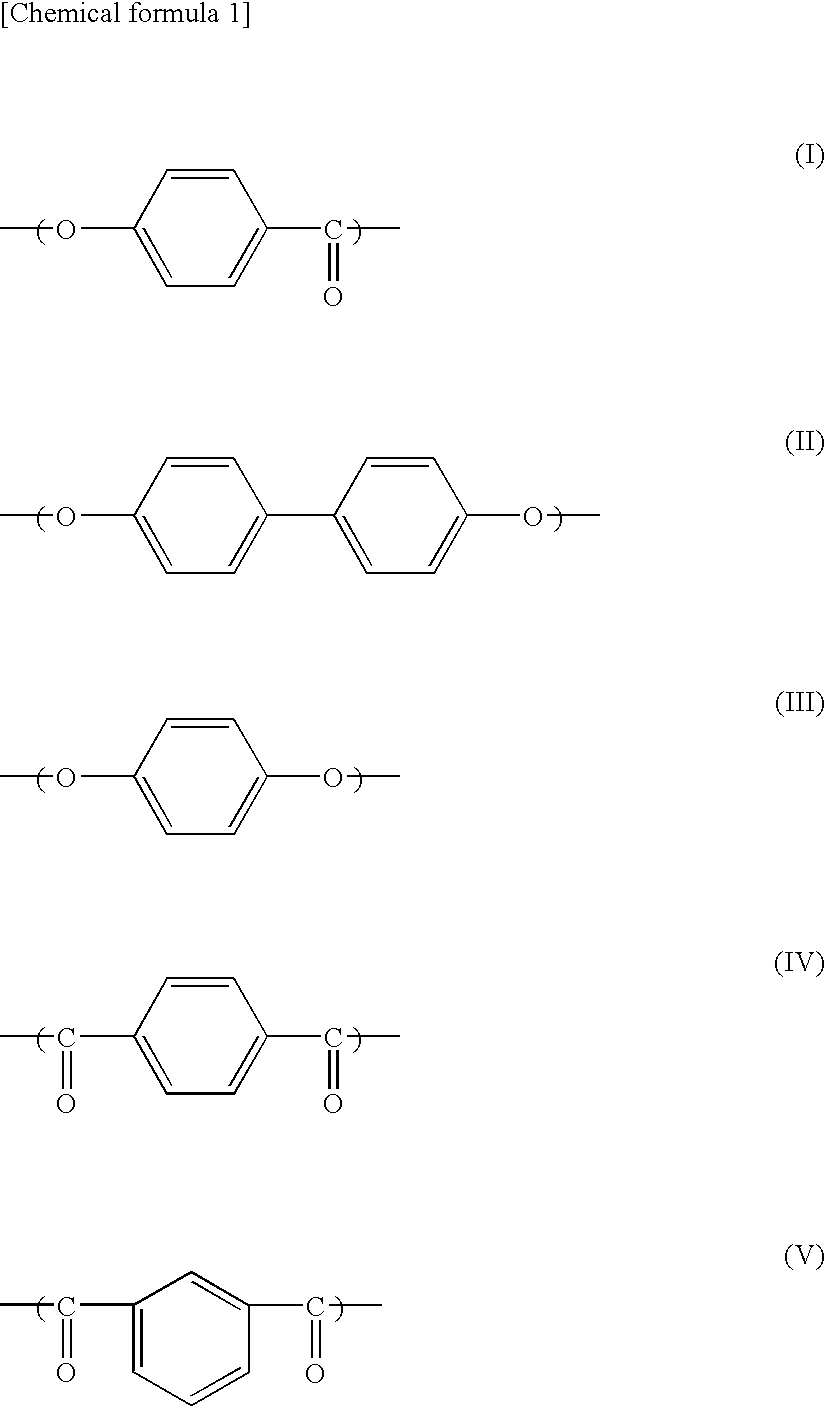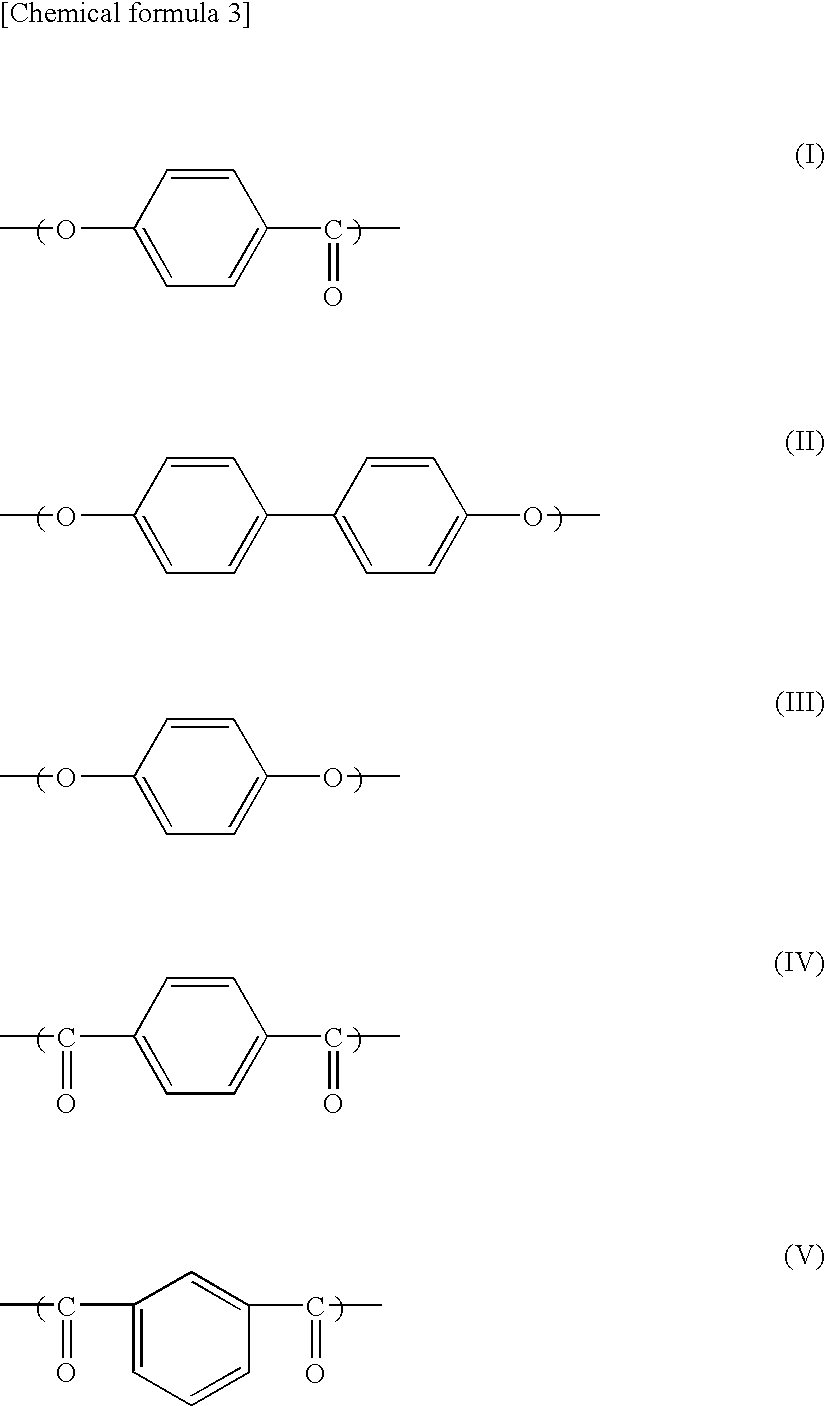Liquid crystalline polyester fiber and process for production of the same
a polyester fiber and liquid crystal technology, applied in the field of liquid crystal polyester fibers, can solve the problems of affecting the uniformity of the uniformity of the uniformity of the uniformity of the uniformity of the uniformity of the uniformity of the uniformity of the uniformity of the uniformity of the uniformity of the uniformity of the uniformity of the uniformity of the uniformity of the uniformity of the uniformity of the uniformity of the uniformity of the uniformity of the uniformity of the uniformity of the uniformity of the uniformity of the uniformity
- Summary
- Abstract
- Description
- Claims
- Application Information
AI Technical Summary
Benefits of technology
Problems solved by technology
Method used
Image
Examples
reference example 1
[0222]p-hydroxy bezoate of 870 parts by weight, 4,4′-dihydroxy biphenyl of 327 parts by weight, hydroquinone of 89 parts by weight, terephthalic acid of 292 parts by weight, isophthalic acid of 157 parts by weight and acetic anhydride of 1433 parts by weight (1.08 equivalent of the sum of phenolic hydride group) were charged into a reaction vessel of 5 L with an agitating blade and a distillation tube, and after the temperature was elevated from a room temperature to 145° C. for 30 minutes while agitated under a nitrogen gas atmosphere, it was reacted at 145° C. for 2 hours. Thereafter, it was elevated to 330° C. for 4 hours.
[0223]The polymerization temperature was kept at 330° C., the pressure was reduced down to 133 Pa for 1.5 hours, and further the reaction was continued for 20 minutes, and at the time when the torque reached 15 kg-cm, the condensation polymerization was completed. Next, the inside of the reaction vessel was pressurized at 0.1 MPa, the polymer was discharged as a...
reference example 2
[0224]p-hydroxy bezoate of 907 parts by weight, 6-hydroxy-2-naphthoic acid of 457 parts by weight and acetic anhydride of 946 parts by weight (1.03 mol equivalent of the sum of phenolic hydride group) were charged into a reaction vessel of 5 L with an agitating blade and a distillation tube, and after the temperature was elevated from a room temperature to 145° C. for 30 minutes while agitated under a nitrogen gas atmosphere, it was reacted at 145° C. for 2 hours. Thereafter, it was elevated to 325° C. for 4 hours.
[0225]The polymerization temperature was kept at 325° C., the pressure was reduced down to 133 Pa for 1.5 hours, and further the reaction was continued for 20 minutes, and at the time when the torque reached 15 kg-cm, the condensation polymerization was completed. Next, the inside of the reaction vessel was pressurized at 0.1 MPa, the polymer was discharged as a strand-like material through a die having one circular discharge port with a diameter of 10 mm, and it was pelle...
reference example 3
[0226]p-hydroxy bezoate of 808 parts by weight, 4,4′-dihydroxy biphenyl of 411 parts by weight, hydroquinone of 104 parts by weight, terephthalic acid of 314 parts by weight, isophthalic acid of 209 parts by weight and acetic anhydride of 1364 parts by weight (1.10 equivalent of the sum of phenolic hydride group) were charged into a reaction vessel of 5 L with an agitating blade and a distillation tube, and after the temperature was elevated from a room temperature to 145° C. for 30 minutes while agitated under a nitrogen gas atmosphere, it was reacted at 145° C. for 2 hours. Thereafter, it was elevated to 300° C. for 4 hours.
[0227]The polymerization temperature was kept at 300° C., the pressure was reduced down to 133 Pa for 1.5 hours, and further the reaction was continued for 20 minutes, and at the time when the torque reached 15 kg-cm, the condensation polymerization was completed. Next, the inside of the reaction vessel was pressurized at 0.1 MPa, the polymer was discharged as ...
PUM
| Property | Measurement | Unit |
|---|---|---|
| temperature | aaaaa | aaaaa |
| temperature | aaaaa | aaaaa |
| temperature | aaaaa | aaaaa |
Abstract
Description
Claims
Application Information
 Login to View More
Login to View More - R&D
- Intellectual Property
- Life Sciences
- Materials
- Tech Scout
- Unparalleled Data Quality
- Higher Quality Content
- 60% Fewer Hallucinations
Browse by: Latest US Patents, China's latest patents, Technical Efficacy Thesaurus, Application Domain, Technology Topic, Popular Technical Reports.
© 2025 PatSnap. All rights reserved.Legal|Privacy policy|Modern Slavery Act Transparency Statement|Sitemap|About US| Contact US: help@patsnap.com



